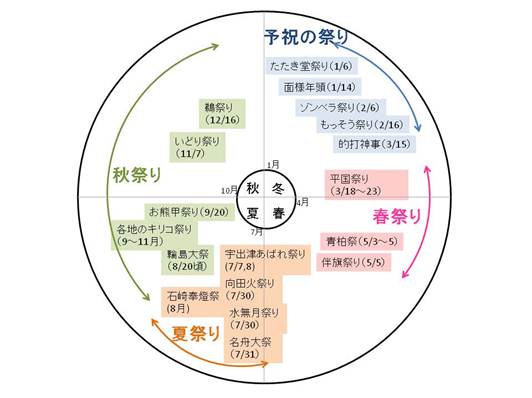Culture and Festivals
Yearly events
Noto, surrounded by the sea on three sides, is said to be a concentration of virgin landscapes, where nature, the Gods and people’s lives have come together seamlessly as one. Since ancient times, various cultures have poured into Noto due to its openness to the sea and shipping routes. Furthermore, since Noto doesn’t have many high mountains, it was blessed with the bounties of the sea, villages and mountains. In Noto, numerous events have developed in order to give thanks for the fruits of the land and sea, as well as praying for new bounties, and these events have developed through time to become integral in the lives of the people and industries of the area.
The yearly events held in Noto can be loosely grouped into those relating to agriculture (rice paddies) such as ‘Aenokoto’ (a harvest ritual), those relating to forestry (the mountains) such as mountain festivals, and those relating to fishing and the sea such as ship festivals and the Amamehagi festival, which are held throughout the cycle of seasons in line with appropriate times in the agricultural, forestry and fishing calendars. As shown in the diagram below, there is a diverse range of events that have been continued up until modern times, and today, those events are integral to daily life and held in line with the cycles of nature.
Religious events and festivals
A feature of religious events and festivals in Noto is that they are held as an integral part of the industries and lives of people in the area, as a legacy of the religious activities of olden times. They are held in line with the yearly rhythm of the agricultural, forestry and fishing industries of Noto’s satoyama and satoumi, and of the lives of the people, and are classified into 4 types. They are the rice cultivation festival held at the start of the year, the Spring festivals starting with the Heikoku festival (18-23 March), the Summer festivals that often start in June of the traditional calendar in which people pray for assistance over the hot summer period and hold the meaning of driving away the evils of the first half of the year (purification), and the autumn festivals beginning with the Wajima Festival (20 August) in which appreciation is shown for the harvest and prayers are made for the following year. Furthermore, Noto, surrounded by the sea, also has some other unique religious festivals such as the Kiriko festivals, the Sea God festival and the Ebisu festival. Furthermore, the shrines and sacred forests where these religious events and festivals are held have both value in terms of biodiversity and culture.

Diagram: The yearly cycle of Noto Peninsula religious events and festivals
Rice cultivation festivals
Tatakido Festival (6 Jan)
Mensama Nento Festival (14 Jan)
Zonbera Festival (6 Feb)
Mosso Festival (16 Feb)
Matochishinji Festival (15 Mar)
Spring Festivals
Heikoku Festival (18-23 Mar)
Seihaku Festival (3-5 May)
Tomohata Festival (5 May)
Summer Festivals
Ushutsu Abare Festival (7,8 July)
Mukodahi Festival (30 July)
Minazuki Festival (30 July)
Nabunetaisai Festival (31 July)
Ishizaki Hoto Festival (Aug)
Autumn Festivals
Okumakabuto Festival (20 Sep)
Various Kiriko Festivals (Sep-Nov)
Wajima Festival (Approx 20 Aug)
Idori Festival (7 Nov)
U Festival (16 Dec)
v. FUJIHIRA (2011), p.5
vi. Ishikawa Prefectural Board of Education (1999) p.19











